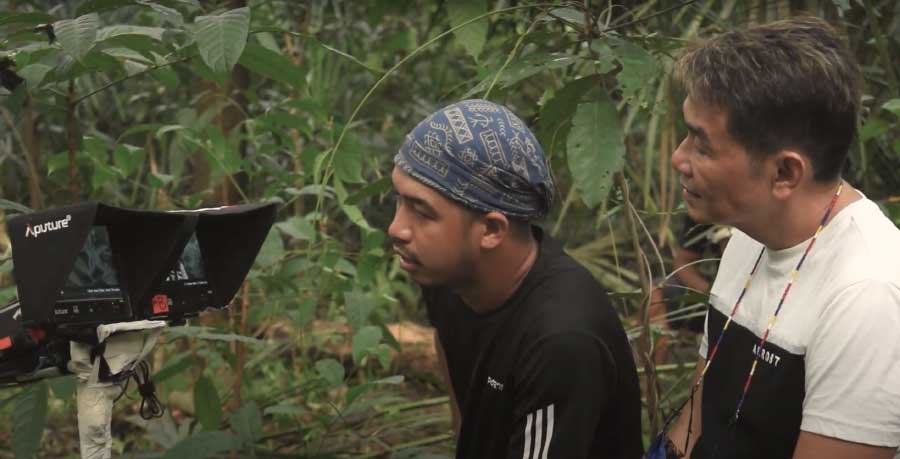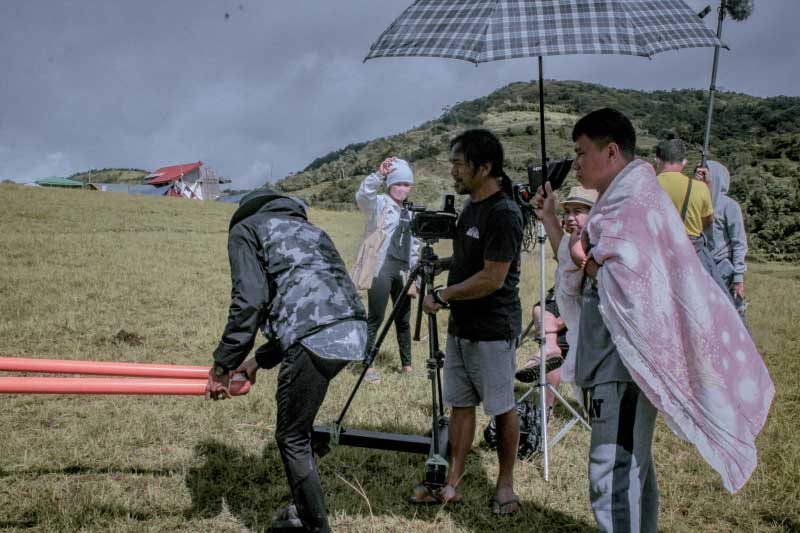By Rjay Zuriaga Castor and Mariela Angella Oladive
In the enchanting world of cinema, where imagination knows no bounds, it takes a truly extraordinary creative team to bring magic to life on the big screen.
Setting foot on this year’s Cinemalaya Film Festival 2023 is the lone Ilonggo entry, “Bulawan nga Usa.”
Behind the masterpiece, are brilliant Ilonggo filmmakers who worked collaboratively to transport us into a fantastical realm of a spellbinding film about a man who goes into a mystical mountain in search of the legendary golden deer.
As fate intervenes, his journey takes an unforeseen turn when he befriends a spirited young mountain boy, further adding layers of depth and allure to this Ilonggo film.
THE MAKERS
Behind the compelling storyline is the writer-director Kenneth De La Cruz, a young and experienced regional filmmaker born and raised in Arevalo, Iloilo City. Among his short films are Tatay Gabok, Luha sang Bulalakaw, and Tangis, all of which have received grants and awards.
De La Cruz wrote the story before the call for Cinemalaya submissions. Feeling disheartened about filmmaking in late 2019, he found inspiration and encouragement from award-winning Ilonggo filmmaker Kevin Pison Piamonte, the executive and creative producer of the film.
“After our conversation, the first story I wrote was Bulawan nga Usa, which is supposed to be a short film. And along with the development of the script, the story is getting its inspiration from my personal artist journey,” De La Cruz told Daily Guardian.
Meanwhile, Piamonte shared that he was convinced about De La Cruz’s beaming potential upon watching his other films.
“Cinemalaya is a boat of dreams. [Its] balanghai and Bulawan nga Usa is about what we may aspire for ourselves, about our wishes, about what we want to be. This is not exactly a smooth journey – like the journey that Makoy took. We are all Makoys. We all have our dreams because we want to be our own person,” Piamonte added.
The film’s concept is rooted in Ilonggo culture, specifically a regional myth about the golden deer in the mountains of Dingle and San Enrique.
Piamonte shared that according to the film colorist, who has roots in the place where the legend originated if one goes up to those mountains, people in the lowlands would still ask if they will go in search for the golden deer — “Mangita ka man sang bulawan nga usa?”
MOVING MOUNTAINS
But there is no gold without facing obstacles, pushing boundaries to achieve the immersive mystical experience of finding the golden deer; the creative team bravely took on an “against all odds” journey just to finish the film as they were confronted with some challenges.
The film was shot over a span of 10 days in the mountainous regions of Alimodian and Miagao in Iloilo.
“It was a conscious decision to film in Miagao because Miagao is our community. We are teachers in UP Visayas, and the town is home to us too. We are also friends with the [local government unit]. And our [location] and production manager John Ray Moleño is from Miagao. We were certain he could move mountains so that filming would be smooth,” said Piamonte.
For Moleño, one of the major challenges in shooting the film is the location that the film requires. Most scenes in the film are in a mountainous area located in a far-flung barangay which can only be reached by riding a motorcycle available for rent.
“An additional challenge during the shooting days was the continuous rain that had made the uncemented road even more difficult to pass by. Some of the crew chose to just walk while some took the risk of riding the motorcycles,” Moleño added.
Another challenge faced by the team was the casting process.
“We had a call for auditions for interested Ilonggo actors, but it was not easy to cast young kids that can act as a mountain boy,” said De La Cruz.
However, Piamonte came up with a suggestion to conduct auditions directly at the shoot location, in the mountains. And from the local community in the area, they eventually found their Minggo, the spirited young boy.
“You don’t stop until you get it. When you think you have the cast, you will know it. Your gut tells you this. In Filipino it’s like ‘lukso ng dugo’,” said Piamonte.
More than moving into the mountains, what truly moves the mountains are the team’s passion and dedication to creating the Ilonggo masterpiece.
“Cooperation of the members of the community or barangay, especially the local officials, made it easier for the team to surpass all those challenges… Aside from the passion that each of the cast and crew brings with them, it was also preparation on the production, logistics, and coordination that had made the film shooting manageable in this kind of location,” Moleño said.
“The entire shoot actually — from the mountain to the town of Miagao and the UP Visayas campus — was the ‘Bulawan nga Usa’ journey. This is what Kenneth wanted to [become] — a filmmaker. This is his ‘usa’ — his golden deer,” Piamonte explained.
THE ‘MAKOY’ IN US
Bulawan nga Usa, though deeply rooted in Ilonggo culture, is a film that resonates with a wide audience.
“This is a regional film, but at the same time personal,” said Piamonte.
Citing the famous Asian director Peter Chan in a film lecture he once attended at the Busan International Film Festival, he said “the personal is also universal.”
“While this film may be Kenneth’s journey from [being] an accountant to a filmmaker, it is also universal because we also take on a journey in ourselves. We also have self-doubts. And we all have to go in search of something at one time or the other,” Piamonte added.
Meanwhile, De La Cruz said Bulawan nga Usa embodies a life lesson, a parable that resonates with all of us. As Filipinos, we hold grand aspirations, and the film encourages us to pursue those dreams relentlessly, just like searching for the golden deer.
“The film is about a journey to self-discovery. The main character is relatable for everyone who is not sure of their purpose in life so they are full of doubts and that prevents them from taking a step forward,” he said.
“However, there will always be people who see potential in us and they support our dreams along the way. I hope this film will inspire the audience to follow their dreams and be grateful to the kindness they receive along the way,” De La Cruz added.
He also hopes that this film will not only motivate the audience but also encourage Ilonggo filmmakers to explore more stories from the community since there are so many beautiful folklores, myths, and untold tales waiting to be unearthed and shared with the world.
AN ILONGGO PRIDE
The burgeoning film industry in Iloilo is undeniably one of the essential elements contributing to the region’s cultural pride. With a multitude of critically acclaimed films and talented filmmakers, the local cinema scene has become an integral part of Ilonggo culture. Hence, Bulawan ng Usa is undoubtedly an Ilonggo pride.
“It is an honor to tell an Ilonggo story in a national film festival like Cinemalaya. It gives us an opportunity to showcase Ilonggo talents on the national stage and hopefully, it opens doors to more Ilonggo artists,” De La Cruz said.
Piamonte firmly believes that Bulawan nga Usa is a testament to the capability of Ilonggos to create films that meet the high standards expected nationally and internationally.
“We also want to say that as Ilonggos, we can also be a good representation of regional filmmaking. We can make a film that we can be proud of; that is at par also with both national and international standards. Bulawan nga Usa is an entirely Ilonggo-made film. We have challenges, but we all stood our ground,” he explained.
Throughout the film’s creation, the team strived to ensure that every aspect remained deeply rooted in Ilonggo’s identity. From the meticulous post-production process, encompassing animation, coloring, and sound, to the entire team involved in its creation, the film outsourced the wealth of talent found within the Ilonggo community.
“We have made sure that the film will make any Ilonggo proud, especially [since] the entire team is made up of Ilonggos… We are very much Ilonggo grounded,” Piamonte said.
























